Nintendo GameCube
Top 10 Best Nintendo GameCube Games of All Time!
You’d never guess it by looking at the console, but the GameCube was considerably more powerful than the PlayStation 2 and even more capable than the Xbox in some respects. Unfortunately, Nintendo’s first disc-based system was child’s play in the eyes of many. Nintendo published M-rated titles for the console and worked with Capcom to bring Resident Evil to the GameCube, but their efforts were not enough to change public perception. Nintendo’s failure to embrace online gaming was another setback, and the concept of “connectivity” between the GameCube and the Game Boy Advance was not fully realized. Nintendo was unable to make up the market share they lost with the Nintendo 64. Sales of the GameCube lagged far behind those of the PlayStation 2 and it ultimately finished in third place for its generation. Despite the disappointing sales, new franchises were born on the GameCube and many old ones were refreshed. Third-party support dwindled with each passing year, however, so the GameCube library was largely defined by the strength of Nintendo’s first-party lineup.
10
Viewtiful Joe
2003
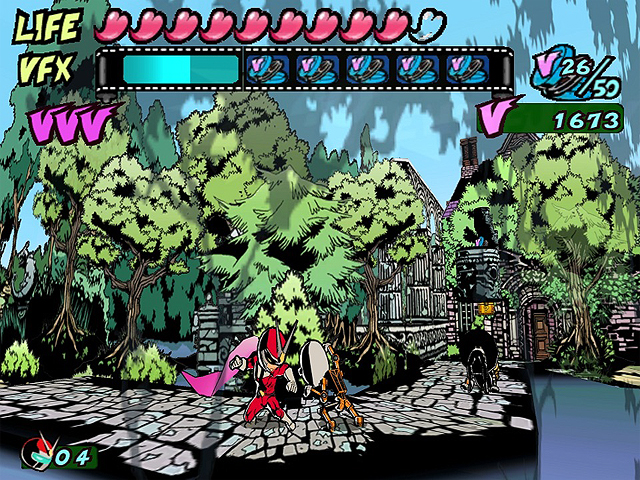
The 32-bit era ushered in a new generation of 3D games, but there were many casualties along the way and side-scrolling “beat ’em ups” basically disappeared altogether. Viewtiful Joe helped rectify this tragedy and attempted to breathe new life into the genre. The game features a unique visual style, and its cel-shaded graphics make the game look like a moving comic book. The gameplay itself fits nicely with the visual themes, and the story focuses on the adventures of a fledgling superhero. Naturally, no superhero would be complete without super powers of some sort. Players have basic punches, kicks, and jumping attacks at their disposal, and they’ll also have the opportunity to slow down time, increase their speed, or zoom in on the action in order to unleash a variety of devastating combo attacks. While the action is generally confined to two dimensions, enemies will also emerge from the foreground and background and attack from all directions. By utilizing their various abilities, players will be able to dodge attacks Matrix-style or punch bullets right out of the air! It’s hard to believe, but the play mechanics in Viewtiful Joe are every bit as stylized as the graphics are. The action is frenetic, the challenge is intense, and the game reminds us why beat ’em ups were so popular in the first place.
9
Resident Evil
2002
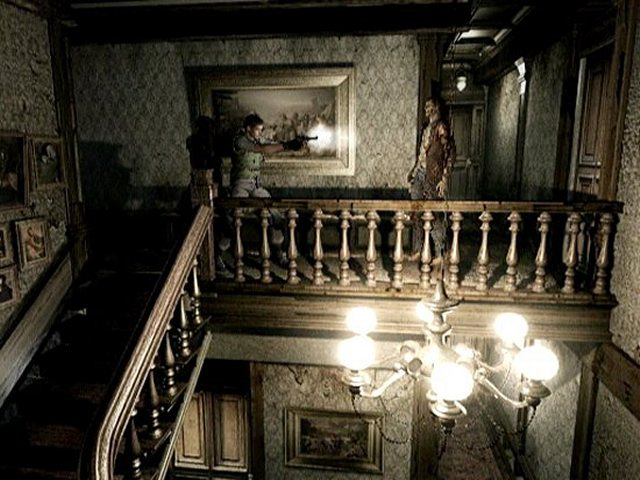
Resident Evil is a remake of the groundbreaking survival/horror game that was released on the PlayStation in 1996. The most obvious difference between the remake and the original is the graphics. Simply put, Resident Evil for the GameCube is one of the best-looking games of its generation. The game has a photo-realistic quality to it, and the pre-rendered backgrounds (laced with full-motion video and real-time lighting effects) are stunning. Beneath the surface, Resident Evil for the GameCube featured other significant improvements over the original. It’s almost unfair to describe the game as a simple remake. After all, 70% of the game is comprised of new content. The game features different layouts, new enemies, a re-written script, and brand new areas to explore. Certain gameplay elements were tweaked as well. (For instance, players can now utilize various defensive weapons in order to fend off their attackers.) Capcom also went out of their way to increase the replay value by adding additional characters and multiple endings to discover in accordance to the paths that were taken during the game. A number of unlockable secrets and game modes help extend the replay value even further. Resident Evil for the GameCube is arguably the best traditional survival/horror game of all time and basically renders the original PlayStation version obsolete.
8
Pikmin 2
2004
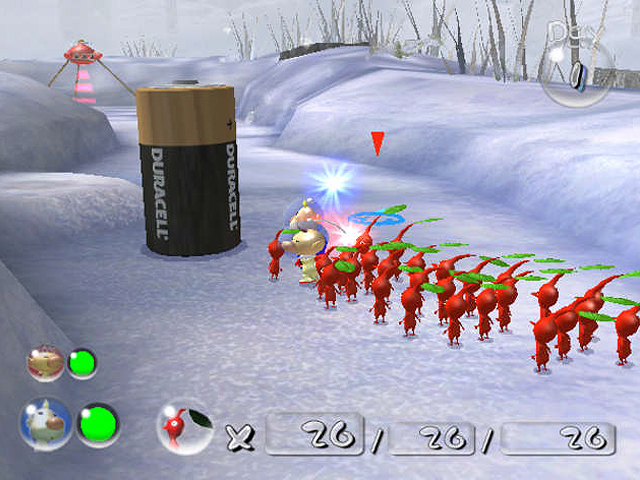
The brainchild of Shigeru Miyamoto, Pikmin was arguably the most creative launch title for the GameCube and a perfect example of how a console-based real-time strategy game should be designed. The game featured an easy-to-understand control scheme that utilized as few buttons as possible, and this allowed the focus to be kept on the actual strategy aspects of the game rather than on micro-management. In essence, Pikmin somehow manages to be both simplistic and deep at the same time. The premise of the game involves a lost space explorer who has to recruit the help of plant-like creatures called Pikmin in order to locate and retrieve parts to his spaceship that are scattered across the planet’s surface. There are various types of Pikmin to recruit (each with their own unique abilities) and the strategy revolves around deciding which type of Pikmin to use in any given situation. The imaginative environments, creative premise, and intuitive control scheme made Pikmin an instant classic, but the sequel improved upon the original in several ways. It included a new multiplayer mode, added new Pikmin species, featured larger areas, and addressed the shortcomings of its predecessor. Pikmin 2 no longer restrains players with a time limit and basically allows them to play the game at their own pace. This allows for a more relaxing experience, and it makes the game even more enjoyable than the first game was.
7
TimeSplitters 2
2002
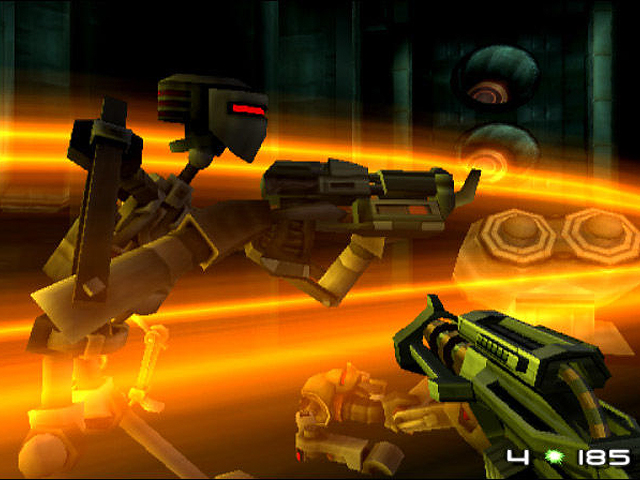
TimeSplitters 2 feels very reminiscent of GoldenEye and Perfect Dark. This is because the staff of Free Radical Design was largely comprised of employees who had previously worked for Rare. Like its spiritual predecessors, the TimeSplitters series doesn’t give players the ability to jump, and it keeps the focus on the shooting aspects instead. The franchise wasn’t nearly as flashy as other shooters from the era, but the clean visual style and relatively simplistic level designs make it easy for the player to tell exactly what they can interact with. The gameplay itself is about as straightforward as you can get, but the mechanics are undeniably solid and the controls are perfect. TimeSplitters 2 is fairly grounded in certain respects, but it really lets loose with regards to its storyline, characters, and missions. The game’s time travelling gimmick allows for tremendous variety. One minute players will be chasing monkeys through ancient ruins, and the next they’ll be fighting on an alien space station. Players will also encounter outlaws in the wild west, chase down bootleggers in prohibition-era Chicago, and engage in battle with robots in a war-torn future. Appropriately, the weapon selection is just as varied as the missions themselves, and players have everything from crossbows to futuristic lasers at their disposal. In addition to an entertaining story mode, TimeSplitters 2 also features dozens of mini-challenges that include everything from shooting watermelons to shooting the heads off of zombies. The multiplayer modes are also phenomenal. The usual four-player split-screen battle mode makes an appearance, and the game also supports two-player co-op for the game’s main story mode. The ability to unlock new characters, earn trophies, and access a variety of cheats helps make TimeSplitters 2 one of the most rewarding (and addicting) games of all time.
6
The Legend of Zelda: The Wind Waker
2002
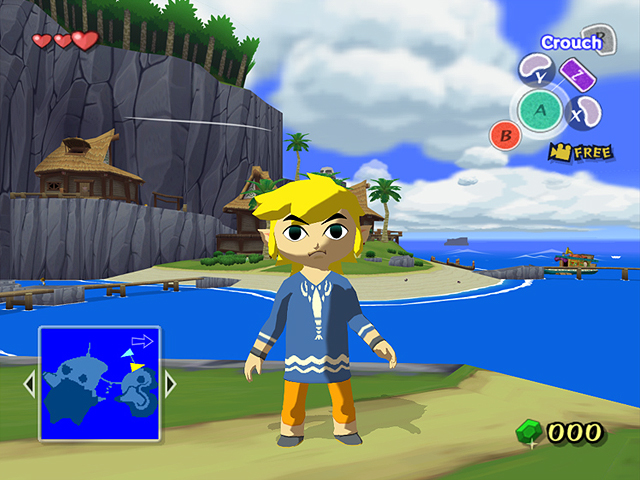
The Wind Waker is perhaps best known for its use of cel-shaded graphics. It was a bold move for Nintendo to adopt a highly-animated visual style for the Zelda series, but not everyone was happy with the direction. While most people admired the vivid artistry, some so-called “hardcore” gamers viewed the game as childish and refused to give it a chance. It was their loss. The Wind Waker featured some of the most memorable environments ever seen in a video game, and this was largely due to the ambitious art style. The incredible animation and exaggerated facial expressions helped define the characters. Despite the new approach from an aesthetic standpoint, The Wind Waker essentially plays like the Nintendo 64 Zelda games do. The target-driven battle system and other fundamental game mechanics were carried over from previous Zelda games, but everything feels a lot more polished and refined. The Wind Waker also boasts some of the best level designs in any Zelda game. The game is not perfect though. The overworld is comprised of a vast ocean, and there seems to be a lot of wasted space. Moreover, the sailing gimmick starts to feel monotonous after a while, and some of the fetch quests near the end of the game are downright tedious. Even though The Wind Waker falls short in a couple areas, it still ranks as one of the greatest adventure games of all time.
5
Super Smash Bros. Melee
2001
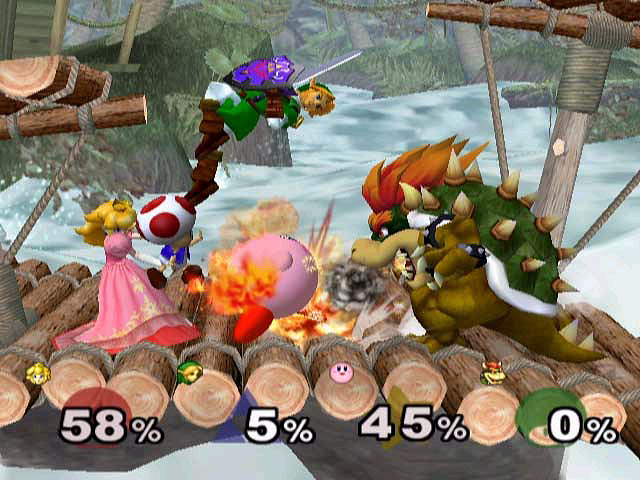
Since there was no Mario game on deck for the launch of the GameCube, Super Smash Bros. Melee took the mantle as the killer app during the console’s launch period. Needless to say, the game was a smashing success and went on to become the best-selling game released on the Cube. It’s easy to understand why the game is so appealing. The idea of a crossover fighting game is nothing new, but you wouldn’t have to go out on too much of a limb to suggest that Nintendo has created more iconic characters than any other video game company in history. Even though the characters, stages, and background music in the Smash Bros. games are familiar, the gameplay itself is highly unorthodox and unlike any other fighting game series. The four-person mutliplayer gimmick sets the stage for hectic battles, and random items and power-ups make things even more unpredictable. Some hardened gamers will argue that Melee is more of a party game than a fighting game. Melee‘s simple interface masks the true depth of the game, and gamers will have to invest a lot of time and effort in order to truly master the game’s precise controls. Melee deserves tremendous credit for expanding on the original game. In addition to the obvious technical improvements, Melee nearly doubled its roster of playable characters, introduced a new “adventure mode” that allowed players to work their way through various Nintendo-themed stages, and included a plethora of minigames and unlockable bonuses. The original Super Smash Bros. was a great game in its own right, but Melee helped cement the series as one of Nintendo’s top franchises.
4
Metroid Prime
2002
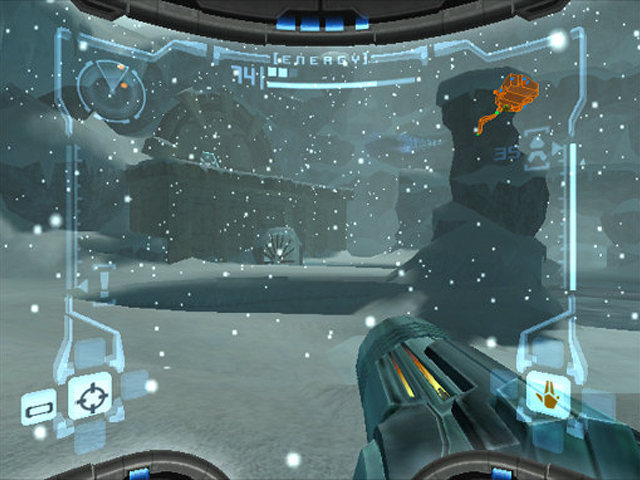
Metroid was noticeably absent from the Nintendo 64’s lineup, so the GameCube release was highly anticipated. Upon learning that the new Metroid game was being developed as a first-person shooter, the hype surrounding the game was replaced with skepticism. Fortunately, Metroid Prime wasn’t really a first-person shooter at all. The game is played from a first-person perspective and involves shooting things, but it’s still a Metroid game at its core and could best be described as a first-person adventure game. The control scheme is both innovative and intuitive, and it works well for both shooting and platforming. Metroid Prime is an incredible achievement from a technical standpoint, and it does a great job of showcasing the GameCube’s power. The environments are loaded with detail, and this is one of the reasons why the game works so well. The exploration-based gameplay requires players to become familiar with their surroundings, so it’s paramount for each area to feel different from the next. Without a hint of hyperbole, Metroid Prime could be labeled as one of the most atmospheric games of all time. The initial skepticism was understandable, but the game was worthy of the Metroid name. It would have been ranked even higher on this list if the boss fights weren’t so poorly designed. Everything else is virtually flawless.
3
Mario Kart: Double Dash!!
2003
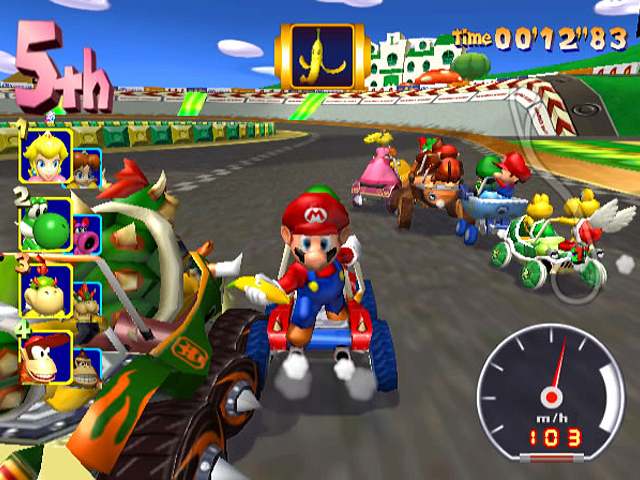
The most obvious difference between Double Dash!! and earlier Mario Kart games is the fact that there are two racers on each kart. The concept of a co-op racing game is extremely creative, and it allows one character to drive while the other manages items. Working together to perform power slides around corners or trying to time the speed boost at the beginning of a race is a lot of fun. This unique co-op dynamic makes Double Dash!! a perfect game for veterans and novices alike. Double Dash!! is loaded with content. There are more characters than in any previous Mario Kart game, and there are also special karts and items associated with each character. (For example: Mario has fireballs, the Kongs have giant bananas, and the baby characters have a giant chain chomp that can drag them around while wreaking havoc on the track.) The stages themselves are also full of personality and are especially effective at highlighting the mechanics of the power slide. Racing around in Baby Park feels completely different than racing in Wario Coliseum or down DK Mountain. Double Dash!! makes several changes to the item management system, and is the first Mario Kart game in which you lose your items after being hit. Because of this, the game has a pronounced risk/reward dynamic that was not really present in the previous games. You might be tempted to save a speed-boost mushroom for later; but the longer you hold onto it, the more likely you are to lose it. Being able to reach over and steal items from nearby racers was another nice touch. All in all, Double Dash!! is an incredible game on every level and stood as the best game in the series until Mario Kart 8raced onto the scene 11 years later.
2
The Legend of Zelda: Twilight Princess
2006
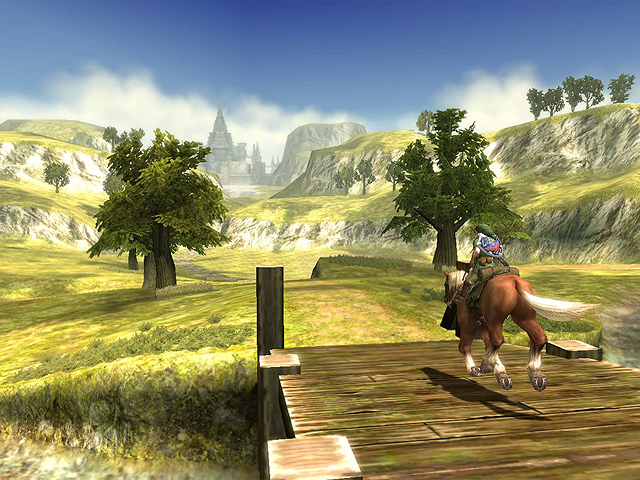
When Nintendo unveiled Twilight Princess to the public at the 2004 E3, they transformed a room full of adults into a bunch of screaming man-children. I’d be lying to say that I wasn’t a little excited too. I adored The Wind Waker‘s cel-shaded graphics and gameplay refinements, but the visual style in Twilight Princess seemed more in line with Ocarina of Time. In many ways, Twilight Princess looked like the game Nintendo had promised before the GameCube even launched. For the most part, Twilight Princess stays true to the standard Zelda formula. The structure of the game still revolves around acquiring new items in dungeons, and then using these items to solve puzzles and defeat bosses. Twilight Princess never feels like a rehash of previous Zelda games, however, because the items themselves are highly creative. For example, the “spinner” item (which allows Link to ride on rails situated throughout the game) is completely unlike any item that has ever been featured in the series. As such, any puzzles or boss battles based around the item also feel fresh. Twilight Princess also finds creative uses for classic Zelda items. (The ability to use your iron boots to walk on magnetized walls and ceilings was greatly appreciated.) Twilight Princess does have a few faults, though. The overworld seems a little empty, and the game doesn’t really take the whole “transforming into a wolf” gimmick as far as it could have. Thankfully, the dungeon designs in Twilight Princess are fantastic and each one feels radically different from the next. The game was delayed on numerous occasions and overshadowed by the Wii version in some regards, but Twilight Princess was a worthy successor to Ocarina of Time and a wonderful swan song for the GameCube.
1
Resident Evil 4
2005
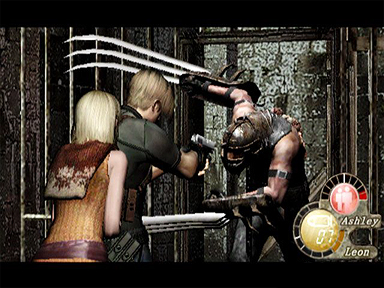
Resident Evil 4 is easily the biggest third-party title on the Game Cube and was arguably the most significant third-party release on any Nintendo console in over a decade. The game was notable for rebuilding the Resident Evil series from the ground up and redefining the entire survival/horror genre. Resident Evil 4 abandons the static camera angles and tank-like controls of its predecessors in favor of a new immersive “over-the-shoulder” vantage point that gives players more control over their characters. The enemies in the game are more numerous than they were in previous installments and show a higher level of intelligence. During the game, the enemies will break down doors, set up ladders to climb into second-story windows, and alert other enemies to your location. The end result is a game that feels more like a traditional action game than previous Resident Evil games did. Having said that, it’s not as though the game completely abandons the survival/horror genre. The atmosphere is dark and mysterious, the story is full of surprises, players are strongly encouraged to conserve ammo, the game still limits the number of items they can carry, and there are surprises waiting around nearly every corner. The relentless pacing of the game forces players to the edges of their seats, and the game has numerous ways of killing players without warning. Chainsaw-wielding villagers can chop your head off in an instant, gigantic lake monsters can swallow you whole, and rolling boulders can turn you into a pancake right quick. Resident Evil 4 is easily one of the best-looking Game Cube games and the production values are second-to-none. Thrilling action, impressive boss battles, and a compelling storyline secure its position as the single greatest game of its generation.

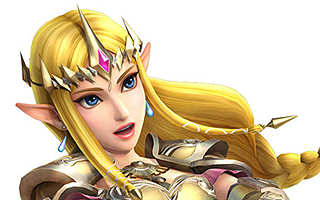
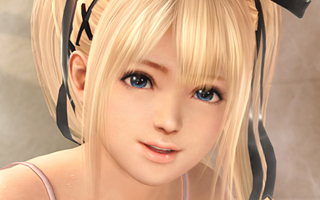
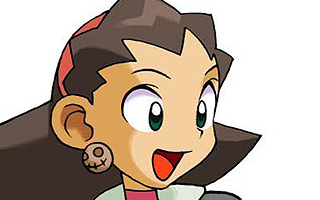
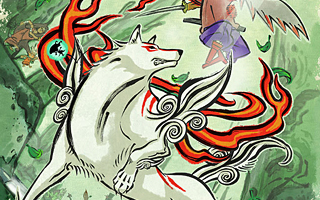
Do you agree with this list? Let us know what you think by leaving a comment below. Your opinion matters!